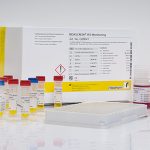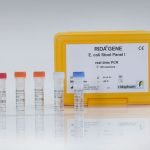Intended use:
For in vitro diagnostic use. RIDA®GENE Legionella is a multiplex real-time PCR for the direct, qualitative detection and differentiation of Legionella pneumophila and Legionella spp. from human tracheal secretion, sputum and bronchoalveolar lavage fluid (BAL).
The RIDA®GENE Legionella multiplex real-time PCR is intended for use as an aid in diagnosis of respiratory infections caused by Legionella.
General information:
The Genus Legionelle belongs to the family of Leginellaceae and can be divided in over 40 species with more than 70 serogroups. Legionella are facultative, intracellular gram-negative bacteria and their infectious peak occurs during the summer months and early fall. One differentiates between community-acquired infections, travel-associated disease and hospital-acquired infections. In the US, the mortality rate of hospital-acquired Legionella infections is between 15 – 20%. In Europe, 12% of all Legionella infections are fatal. Of the broad variety of Legionella species, two human pathogenic species are of importance. L. pneumohila primarily causes Legionnaire’s disease and L. longbeachae results in Pontiac fever. Pontiac fever is an acute self-limiting influenza-like diseases, however, no pneumoniae occurs. About 7% of people infected with Legionella develop Pontiac fever.3 L. pneumophila has 16 serogroups, whereas about 70% of all Legionella infections in Europe are due to L. pneumophila serogroup 1. Other Legionella species that result in an infection are for instance L. micdadei, L. bozemanii, L. dumoffii and L. longbeachae.
Legionnaire’s disease is an acute respiratory infection which is caused by L. pneumophila in 90% of cases. In 1976, this disease was first described during a meeting of the American Legion in Philadelphia, hence the name of the disease. In 2013, two other outbreaks of Legionnaire’s disease with a total of 6 fatal cases were reported in Brisbane, Australia and Reynoldsburg, Ohio. Symptoms include fever, cough (dry or sputum producing) and shivering. Other, less common symptoms are diarrhea, vomiting, bradycardia and hypnatremia. People of every age can be infected, but old people as well as smokers and patients with chronic lung infection are more prone to such a disease.
Even in countries with an effective health care system almost 90% of cases of Legionnaires’s disease are not diagnosed since the clinical presentation can differ substantially and the disease is so rare.
In addition, it is very difficult to differentiate Legionnaire’s disease from other pneumonia solely on the basis of symptoms or by chest X-ray. Therefore, sensitive and specific detection methods such as real-time PCR offer an advantage for the detection of Legionella infections.
| Art. No. | PG8005 |
|---|---|
| Test format | real-time PCR with 100 reactions |
| Shelf life | 24 month after production |
| Sensitivity | Analytical Sensitivity : ≥ 10 DNA copies per reaction |
Dear customers,
we have started to provide the documents for our products in an electronic format. These are the Instructions for Use (IFU), the Safety Data Sheets (SDS) and the Certificate of Analysis (CoA). For batches placed on the market after 01 January 2023, you can find our documents on the eIFU portal eifu.r-biopharm.com.










